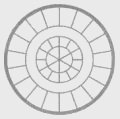
 |
Hokupa'a Basics |
A diagram of Hokupaa is shown below. This image is a representation of the major components in the adaptive optics system. It isn't exactly the layout of the components in the Hokupaa that is currently installed on Gemini as this particular diagram is simply an edited version of the CFHT-Hokupa'a.

The correction is made by a deformable bimorph mirror made from two sheets of piezo-electric material which can be made to introduce local wavefront curvatures. As seen in the figure the correction is made in collimated space. This mirror corrects for all measured aberrations up to the limit of the 36-element curvature wavefront sensor. Note that overall tip and tilt errors are corrected by this same mirror. These tip/tilt errors can arise from non-atmospheric effects such as telescope tracking errors so to avoid using all the deformable mirror's range to correct for tip/tilt, these signals are slowly off-loaded to the TCS to correct for telescope pointing.
The corrected wavefront is then passed to the near-infrared focal-plane instrument QUIRC. QUIRC will receive all light longward of 1 micron. The throughput to the WFS APDs is approximately 40%. The bandpass to the APDs is approximately R-band. Although not shown in the diagram, there is a neutral density filter wheel in front of the entrance to QUIRC for use with very bright sources.
Light with wavelength shortward of 1 micron is sent via a beamsplitter to the wavefront sensor leg. This leg contains a set of neutral density filters, a field steering mirror, a membrane mirror, and the set of lenslet array and avalanche photodiodes. The field steering mirror selects the portion of the field to place into the wavefront sensor. This mirror can place a star within a 12arcsec radius into the wavefront sensor. The membrane mirror provides the means to obtain the two extrafocal images for the curvature measurement and its operation frequency defines the update rate of Hokupa'a. Finally a set of lenslets and matching avalanche photodiodes are used to measure the illumination in the two extrafocal images.
| Wavefront Sensor | Curvature 36 elements, 2 arcsec WFS FOV, 12 arcsec guide star patrol radius |
| Deformable Mirror | 36 element Bimorph 60mm pupil DM stroke sufficient for ~ 0.9arcsec seeing |
| Sampling Rate | 1 kHz |
| Imager | University of Hawaii's QUIRC 1-2.5 micron HgCdTe 1k2 HAWAII array, 19.7 milliarcsec/pixel ~20 arcsec FOV |
Last update 20 December 1999; Mark Chun